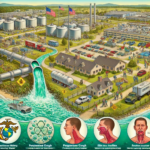Aqueous Film-Forming Foam (AFFF), widely used by firefighters to extinguish fuel fires, has been identified as a significant source of environmental pollution. This foam contains per- and polyfluoroalkyl substances (PFAS), which have been linked to serious health risks and environmental damage. Communities living near military bases, airports, and industrial sites where AFFF has been used extensively are now grappling with contaminated water supplies and health and environmental concerns themselves. The situation calls for legal action to address the harm caused and secure compensation for affected residents.
Mass Tort America is dedicated to helping communities affected by AFFF contamination. Our experienced team understands the complexities of these cases and is committed to fighting for the rights of individuals and communities harmed by this toxic exposure. We aim to provide clear guidance and robust legal representation to ensure justice is served and proper compensation is obtained.
Understanding AFFF And Its Environmental Impact
AFFF has been a staple in firefighting due to its effectiveness in suppressing fuel fires. However, the same chemicals that make it effective to fight fuel fires are also highly persistent in the environment. PFAS, often dubbed “forever chemicals,” do not break down easily and can accumulate in water, soil, and living organisms. This persistence leads to long-term contamination and poses a significant threat to both human health and the environment.
The primary concern with PFAS is their ability to leach into groundwater, affecting drinking water sources. Many communities near sites where AFFF has been used are now facing water contamination. The health risks linked to PFAS include cancer, thyroid disease, immune system impacts, and developmental problems in children. These serious health implications make it essential to address AFFF contamination promptly and effectively.
Environmental damage from AFFF extends beyond water contamination. Wildlife and ecosystems are also at increased risk here, as PFAS can accumulate in the food chain, leading to broader ecological impacts. The widespread use of AFFF has resulted in extensive contamination sites, necessitating comprehensive cleanup efforts and legal measures to hold responsible parties accountable.
Legal Framework For Addressing AFFF Contamination
Addressing AFFF contamination involves navigating complex legal and regulatory frameworks. The Environmental Protection Agency (EPA) has set advisory limits for PFAS in drinking water, but enforceable standards are still developing. This regulatory gap means that affected communities often rely on legal action to seek redress and compel cleanup efforts. Lawsuits against manufacturers of AFFF and entities responsible for its use are becoming more common as awareness of the issue grows.
Litigation typically targets both the manufacturers of AFFF and the entities that used it extensively, such as the military and airports. These lawsuits aim to recover costs for water treatment, medical monitoring, property devaluation, and other damages. Successful cases can result in substantial settlements or judgments, providing much-needed resources for affected communities to address the contamination and its impacts.
The legal process for AFFF contamination cases can be lengthy and complex. It involves gathering extensive evidence, including scientific data on contamination levels and health impacts. Expert testimony often plays a crucial role in establishing the link between PFAS exposure and adverse health effects. Given these complexities, legal representation with specialized knowledge in environmental law and toxic torts is essential for those seeking justice.
Health Effects Of PFAS Exposure
The health effects of PFAS exposure are wide-ranging and serious. Exposure to these toxic chemicals has been linked to several adverse health outcomes. For instance, studies have shown that PFAS can interfere with the immune system, reducing the body’s ability to fight infections. Other significant health effects include thyroid disease, kidney cancer, and liver damage.
One of the most concerning aspects of PFAS exposure is its impact on pregnancy. Pregnant women exposed to PFAS are at higher risk of pregnancy-induced hypertension and low birth weight in infants. These chemicals can also be transferred to infants through breast milk, leading to potential long-term health issues. The need for more research to fully understand the health impacts of PFAS is critical, as existing data already shows significant risks.
Beyond immediate health problems, PFAS exposure has been linked to chronic conditions such as thyroid disease and certain cancers. The National Health and Nutrition Examination Survey (NHANES) has highlighted the prevalence of PFAS in the human body, indicating widespread exposure. This ongoing exposure underscores the importance of addressing PFAS contamination comprehensively.
Regulatory Efforts By The EPA And Other Federal Agencies
The Environmental Protection Agency (EPA) has been at the forefront of regulatory efforts to control PFAS contamination. The EPA’s regulations include setting advisory limits for PFAS in drinking water and developing guidelines for cleanup processes. However, these measures are often seen as insufficient given the scale of contamination and the persistence of these chemicals in the environment.
Other federal agencies, such as the Centers for Disease Control and Prevention (CDC) and the Agency for Toxic Substances and Disease Registry (ATSDR), also play crucial roles. These agencies conduct research on the health effects of PFAS and provide guidelines for exposure limits. Collaborative efforts among these agencies aim to provide a unified response to the PFAS crisis.
Despite these efforts, the regulatory framework for PFAS remains fragmented. State-level regulations vary widely, leading to inconsistent protection for residents. This regulatory patchwork complicates efforts to address PFAS contamination effectively, highlighting the need for comprehensive federal standards.
Impacts on Drinking Water And Public Health
PFAS contamination of drinking water is a major public health concern. Communities near military bases, airports, and industrial sites where AFFF has been used are particularly vulnerable. PFAS chemicals can leach into surface water and groundwater, leading to widespread contamination of public water supplies.
The health impacts of consuming contaminated water are severe. PFAS exposure through drinking water has been linked to various health problems, including cancer, immune system suppression, and developmental issues in children. The Environmental Working Group (EWG) has documented numerous cases of PFAS contamination in drinking water across the United States, underscoring the urgent need for action.
Efforts to mitigate PFAS contamination in drinking water include installing advanced filtration systems and sourcing alternative water supplies. However, these solutions are often costly and require significant investment. Legal action against responsible parties can help secure the necessary funds to implement these measures and protect public health.
Role Of Industry And Consumer Products In PFAS Exposure
PFAS exposure is not limited to firefighting foam; these chemicals are also found in various industry and consumer products. PFAS are used in non-stick cookware, water-repellent clothing, food packaging, and many other items. This widespread use has led to ubiquitous environmental presence and human exposure.
Industrial sites, particularly chemical plants, are major sources of PFAS contamination. These facilities often discharge PFAS into the environment, affecting nearby communities. The long-term environmental and human health effects because of such contamination are profound, necessitating strict regulation and remediation efforts.
Consumer products containing PFAS contribute to daily exposure. These products can release PFAS into the air, water, and soil, leading to cumulative exposure over time. Understanding the sources of PFAS exposure is crucial for developing effective strategies to reduce human health risks and environmental impact.
Addressing PFAS Contamination In Firefighting Training Facilities
Firefighting training facilities are significant sources of PFAS contamination. These sites use AFFF extensively to train firefighters in handling flammable liquid fires. The repeated use of AFFF at these facilities has led to high levels of PFAS contamination in soil and groundwater.
Efforts to address contamination at these sites include transitioning to PFAS-free firefighting foams and implementing rigorous cleanup protocols. These measures are essential to prevent further environmental damage and protect the health of firefighters and nearby communities. Legal action can play a critical role in holding responsible parties accountable and securing funds for remediation.
Training facilities must also adopt new practices to minimize future contamination. This includes using containment systems to capture and treat foam runoff and regularly monitoring PFAS levels in the environment. Such proactive measures are vital to reducing the impact of PFAS on human health and the environment.
Health Concerns Related To PFAS In Breast Milk and Infant Development
PFAS contamination poses significant risks to infant development, particularly through exposure via breast milk. Studies have shown that PFAS can accumulate in breast milk, leading to direct exposure for nursing infants. This exposure is concerning due to the potential for developmental delays and other health issues in young children.
Research indicates that infants exposed to PFAS through breast milk may have higher risks of immune system suppression and reduced antibody response. These effects can make infants more susceptible to infections and other health problems. The long-term implications of such early-life exposure necessitate urgent action to mitigate PFAS contamination.
Protecting infants from PFAS exposure involves both regulatory measures and public awareness. Pregnant and nursing mothers need guidance on minimizing exposure to pfas, and communities must advocate for stricter regulations on PFAS use and disposal. Legal action can help drive these changes and secure safer environments for vulnerable populations.
Scientific Evidence Linking PFAS To Adverse Health Outcomes
A growing body of scientific evidence links PFAS exposure to various adverse health outcomes. Studies have documented associations between PFAS and several types of cancer, thyroid disease, and liver damage. These findings underscore the urgent need to address PFAS contamination and prevent further exposure.
Research has also highlighted the impact of PFAS on the immune system, particularly its role in reducing the body’s ability to fight infections. This effect is particularly concerning for vulnerable populations, such as children and the elderly, who may face higher health risks from compromised immune function.
Continued research is essential to fully understand the health impacts of PFAS and develop effective mitigation strategies. Public health agencies and scientific organizations must collaborate to advance this research and provide clear guidelines for managing PFAS exposure.
Impact on Firefighters: Health Risks From AFFF Exposure
Firefighters are at the forefront of PFAS exposure due to their use of AFFF in extinguishing flammable liquid fires. This occupational exposure poses significant health risks military firefighters, including cancer, thyroid disease, and immune system suppression. Understanding and addressing these risks is critical for protecting firefighter health.
Efforts to mitigate exposure include transitioning to PFAS-free firefighting foams and providing regular health screenings for firefighters. These measures can help detect and manage health issues early, reducing the long-term impact of PFAS exposure. Legal action can also play a role in securing compensation for affected firefighters and funding for health monitoring programs.
Protecting firefighters from PFAS exposure requires a multifaceted approach, including regulatory changes, workplace occupational safety and protocols, and ongoing research. Ensuring that firefighters have access to safe and effective firefighting tools is essential for their health and well-being.
The Role Of Consumer Products In Widespread PFAS Exposure
Consumer products are a significant source of PFAS exposure. These chemicals are used in various items, from non-stick cookware to water-resistant clothing. This widespread use of synthetic chemicals has led to pervasive environmental contamination and human exposure.
Understanding the sources of PFAS in consumer products is crucial for developing effective mitigation strategies. Regulatory measures to limit PFAS use and promote safer alternatives are essential steps in reducing exposure. Public awareness campaigns can also help consumers make informed choices about the products they use.
Legal action against manufacturers of PFAS-containing products can drive industry changes and provide compensation for affected individuals. Such efforts are vital for addressing the widespread impact of PFAS and protecting public health.
Why Choose Mass Tort America For Your Case?
Mass Tort America is committed to supporting communities affected by AFFF contamination. Our team has extensive experience in handling environmental cases and understands the unique challenges posed by PFAS exposure. We work tirelessly to hold responsible parties accountable and secure the compensation needed for comprehensive remediation and health monitoring.
Choosing Mass Tort America means choosing a partner dedicated to your community’s well-being. Our Concierge Team assists clients nationwide, coordinating all aspects of the legal process to ensure a seamless and supportive experience. We prioritize clear communication, expert representation, and unwavering advocacy to achieve the best possible outcomes for our clients.
For more information or to discuss your case, contact us at 800-356-4338 or visit our contact form at https://masstortamerica.com/contact/. Our team is ready to help you navigate this challenging situation and fight for the justice and compensation you deserve.



















